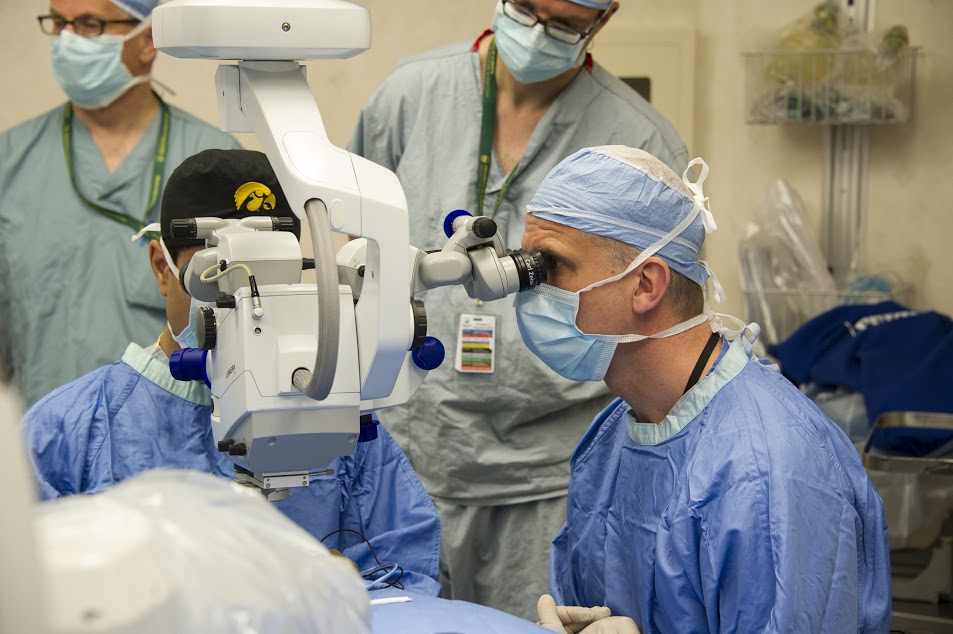
Dr. Rizwan Somani injects a customized virus into a patient's retina in order to transfer a healthy gene
Canada's first human gene therapy trial for eyes-the replacement of a faulty gene with a healthy one-is now underway at the Royal Alexandra Hospital to preserve and potentially restore vision for people with a genetic disorder that leaves them blind by middle age.
"It's a great privilege to be able to do something very positive for people with choroideremia," says Ian MacDonald, a professor of ophthalmology with the Faculty of Medicine & Dentistry at the University of Alberta, and clinical research team leader. "People have hoped for this for a long time."
Choroideremia is a form of inherited blindness that affects one in 50,000 people, about 90 per cent of whom are men. Many experience difficulty seeing at night during their teens, lose peripheral vision in adulthood and are often legally blind by the age of 40. The disease is caused by a faulty gene that results in the degeneration of the light-sensing retinal cells at the back of the eye. Until now, it has been untreatable.
Gene therapy is not a drug, but a transfer of human genes. Gene therapy refers to the incorporation of new DNA into cells, to replace a gene that is either missing or not functioning. This allows the cells to produce an important protein. In choroideremia, this protein is not produced and retinal cells die off over time, causing vision to deteriorate.
MacDonald's trial involves a new treatment intended to stop choroideremia in its tracks with a single injection of what's known as a viral vector-a small harmless virus that's been modified to carry into the eye the "good" gene needed to potentially prevent further loss of sight and to restore the vision of his patients-often with noticeable results in less than a month.
During the procedure, performed under a general anesthetic, a surgeon detaches the area to be injected in the patient's retina, then injects the viral vector through a narrow needle into the back of the eye. The injection carries about 10 billion viral particles, each carrying a working copy of the good CHM gene, to target millions of eye cells.
"We're using the natural properties of a virus-its ability to inject its DNA into human cells-to introduce a working copy of the needed gene into the retinal layers," says Stephanie Chan, genetic counsellor and study co-ordinator. "The idea is that those cells will take up the good gene and use it to create the correct protein, replacing the defective gene that's in the cells."
The first of six local men to undergo ocular gene therapy, Ken Ross had about five per cent vision remaining in his right eye. Following treatment, the 43-year-old Edmonton man already sees improvement in his ability to tell colours apart and distinguish light and shadow.
"I'm still trying to wrap my head around it," Ross says with emotion.
"I didn't foresee this happening in my lifetime. I've been seeing Dr. MacDonald since I was little. I got tested, hoping to take part in the trial, last August. Then my spouse and I went on a cruise. I was sitting on a ship's balcony thinking, 'This is just my lot in life. I'll enjoy the view while I can and keep the memory inside.' And when I came back, I got the call that I qualified for the surgery."
The viral vector, known as AAV2-REP1, was provided by NightstaRx Ltd., a private British biopharmaceutical company focused on the development of therapies for retinal dystrophies.
"We are leading the way in the development of an effective gene therapy treatment for choroideremia, and this new study sponsored by the University of Alberta is another step forward in the development of AAV2-REP1," says David Fellows, CEO of NightstaRx. "We have been granted orphan drug designation for the product in the United States and Europe, and the data to date have shown very promising results."
The first clinical trials took place at the University of Oxford. Results published in The Lancet in 2014 showed that six months after treatment, the first six patients showed improvement in their vision in dim light and two of the six were able to read more lines on an eye chart. Oxford research is ongoing under the direction of ophthalmologist Robert MacLaren.
Funds, support and equipment for the Canadian trial have been provided by various governmental and private agencies, including Alberta Innovates - Health Solutions, Canadian Institutes of Health Research, NightstaRx, Canada Foundation for Innovation, Alberta Innovates (Alberta Innovation and Advanced Education), The Foundation Fighting Blindness, Choroideremia Research Foundation Canada, and private donors.
Researchers believe this new approach to eye therapy has promise for treating people early on, before too many cells in the retina have been lost. It may also have relevance for other, far more common causes of blindness, such as retinitis pigmentosa and age-related macular degeneration.
"If we can maintain the vision our patients have, we would look at that as a success," says Chan. "If there is improvement, that's even better."
MacDonald says he's "absolutely impressed" by the eye's ability to heal itself and reattach the retina within hours of surgery. "The human body is doing its work. We're just helping it."